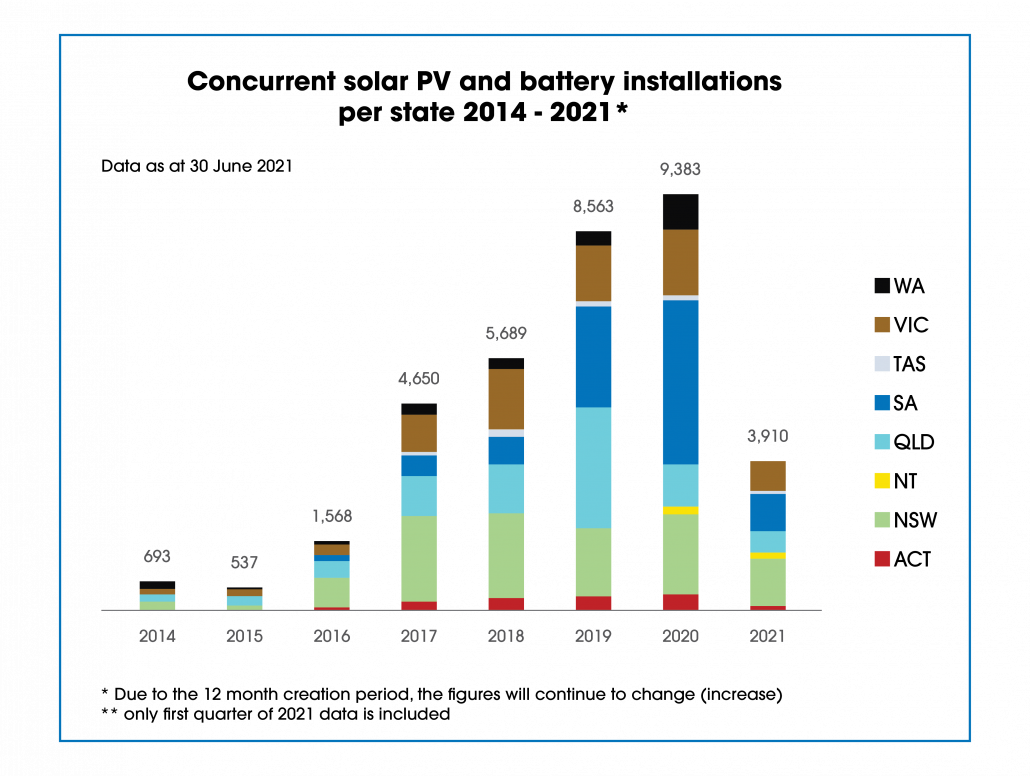Solar is the cleanest source of energy, and it helps thousands of households each year move towards a more sustainable future. If you have been enjoying solar panels for a while, there are plenty of reasons why you might be considering an upgrade to your system with more panels or a battery. Perhaps the family has grown and your home’s energy usage has gone up. Perhaps you have been enjoying Premium Feed-in Tariffs you will no longer have access to, opening the possibility of change. Or, perhaps you are trying to save more money with the rising cost of living. Regardless of the reason, your existing solar system setup might not be suitable anymore – so what is your next step?
No one can deny the financial and environmental benefits of solar power alone. However, the idea behind solar storage solutions is to reduce your reliance on the grid even further, making your solar energy available to use even when the sun’s not shining.
Tens of thousands of Australians are installing solar batteries
Australia has the highest rate of solar panel installations worldwide. In 2020, there was a 20% increase in installations on the year prior, and in the 2021-22 financial year, there was nearly 6000 battery rebate applications approved. Since the advancements of the technology behind solar batteries has made them bigger and more accessible, it comes as no surprise that the trend shows more and more Australians are installing solar batteries. The data in the first two quarters of 2021 showed an estimated total of 35,535 new batteries installed, overtaking the previous 2012 record. In 2022, there are more than three million rooftop solar photovoltaic (PV) systems on homes in Australia. Solar batteries are eco-friendly and effective in storing solar energy and are changing the way that Australians store and use their power generated by their solar PV systems. Australians are definitely jumping on board this journey to cleaner energy. With the current rate of installations, we are likely to see these numbers keep increasing. But why?

Image credit: Clean Energy Regulator data, Australian Energy Council analysis, August 2021
What is the difference between solar panels and solar batteries?
Overall, solar batteries store the energy that solar panels produce that isn’t immediately used in the home. This means the stored energy in the battery can be drawn out later to use within the household.
Solar batteries have come a long way since the technology became first available. Powerful features complement the monetary decision to install a battery, with benefits like 24/7 system monitoring, blackout protection, modular extendable capacity, amongst others. For the most part, none of this is possible by simply adding more panels.
Hence, a solar battery not only will store excess power you would have exported to the grid otherwise, but it opens possibilities to maximise your solar investment. As a matter of fact, an average household with a right-sized battery solution could see a boost in solar energy usage from around 25% to up to 80%. Using more free energy from the sun will decrease your consumption from the grid (and your electricity bills), and when the grid fails, blackout protection will keep your essential appliances running and your lights on.
Modern, modular battery designs – allow the battery’s capacity to increase in the future if needed and also overcome the limitation of available roof space, shading or available inverter capacity you need to consider when adding more solar panels to your system.
One final consideration for the case of batteries is making sure you already export enough to fill its capacity. If not, it would be worth adding more panels at the time of installing a battery. Solar is not a one-size-fits-all kind of solution, so be wary of any company that offers a battery or more panels without trying to understand your home’s energy consumption patterns and what you already pay for power.
The real question in the debate goes beyond panels OR batteries, it is: How can you maximise your energy independence by increasing the usage of solar energy at home in the most cost-effective way?
Generate more power… get lower Feed-in Tariffs?
In 2008, all Australian governments agreed that small-scale solar generators have the right to export electricity to the grid in return for a payment called the Feed-in Tariff (FiT). Premium tariffs of up to 60 cents per kWh certainly helped to cement our solar installation boom during this period.
Now, 14 years later in 2022, FiT’s have significantly decreased in value, and on average are around 5.2c/kWh in Victoria, or 5c/kWh in New South Wales. So what does this mean for you? On its own, lower FiT’s mean the return on investment takes a bit longer. Reality is though, Australians pay exorbitant electricity retail rates from the grid, so not only are you left waiting longer for a return on investment, but you are also slammed with high electricity bills coming from your consumption when solar is not producing energy (like at night).
Thus, the key to saving money now is to buy less electricity from your energy retailer by using your very own stored electricity in the home via a solar battery.
A battery might be for you
The average Australian household doesn’t consume all their energy produced by their solar panels in one day. The energy that is generated and doesn’t get used, is sold to the grid by your energy retailer for less than what you pay to buy it back in the evening. Make sense? That is, unless there is somewhere to store the excess power so it can be used when it is needed, the energy retailer will put it back into the grid for much less than you pay for it.
Without a solar battery, a household can only use its own solar power when it’s being generated. A battery gives our customers greater independence from the grid, so that our customers can power their home at night or in a service blackout*. Extending the use of free energy they are generating through their own solar PV system also means paying less to your energy retailer. Furthermore, if your circumstances change over time, modular architecture lets you expand your battery’s capacity, future-proofing your investment.
So the question is, what’s holding you back from making the change? Take the next step in your journey to zero energy bills and towards energy independence. If interested, why not talk to us today. We can help assess your needs and requirements and customise the perfect battery solution for your energy needs.

![]()




